New Composite Acts Like Natural Enamel
Micerium’s new ENA HRi Universal Enamel is the first and only composite material with the same optical refractive index as natural enamel (See table). This phenomenon makes it the premier solution to resolving common problems with restorative materials (Figure 1).
Natural teeth exhibit different amounts of fluorescence, opalescence, translucency, opacity, chroma, and value. All of these qualities are interdependent, so if one is changed it may adversely affect one or more of the others. A composite must have an exact balance of each of these qualities or it will not have the capability to be used in creating beautiful, natural-looking restorations.
Historically, manufacturers have needed to use special techniques to simulate natural tooth structure, as natural dentin and enamel are very different in their ability to transmit light and in their strength. One idea to create natural-looking restorations was to use standard composite to replace dentin and cover it with a “microfill” composite as the enamel replacement. This was a very complicated technique. While microfill composites polished easily, they were more opaque and did not exhibit the same properties as natural enamel. Also, many additional shades were required because there needed to be a dentin shade and an enamel shade.
Manufacturers then moved to “microhybrid” composites, which use the same material to replace the dentin as well as the enamel. This was a step forward, but because the microhybrid enamel shades appeared different than natural enamel, it still did not provide a truly natural look—particularly with the issue of light passing through the restoration (Figure 2).
With either of these approaches, special margin preparations and layering techniques had to be used to create invisible margins and vital-looking restorations. Even then, another issue that previous restorative materials could not overcome was the “glass effect” at the margins. Once the composite is polymerized, the translucent properties appear gray in direct proportion to its thickness, thus lowering the value of the entire restoration.
Given these difficulties, one can see why traditionally it has been virtually impossible to use layers of composite enamel in the same thickness as the natural enamel—until now.
ENA HRi simplifies composite restorations. Because it has the same optical refractive index (n 1.62) as natural enamel, no special margin preparation is needed. When applied in the same thickness as natural enamel, margins disappear (Figure 3 and Figure 4). When the preparation involves the dentin, only one or two dentin shades are necessary with the Universal Enamel shade to create a perfect, esthetic restoration. This means that when restoring a tooth, the natural enamel layer is replaced with a layer of the same thickness. There is no more guessing how thick to make this final layer with invisible margins. An additional benefit to these layers being the same thickness is that the restoration will wear or age at the same rate as the restored tooth as well as the adjacent teeth.
ENA HRi also matches the opalescent and iridescent properties of natural enamel, eliminating the need for incisal enamel shades and solving the problem of metamerism (Figure 5 and Figure 6). As this material exhibits the same characteristics as natural enamel, it optically changes from amber to blue in the incisal area depending on the angle and amount of light passing through. ENA HRi dentin shades also match the fluorescence of natural dentin, which adds to the natural look of restorations.
Because the ENA HRi system clones the attributes of natural tooth structure, creating natural-looking restorations is something that will be much easier for dentists to achieve no matter if they are just starting to do esthetic work or they have many years of experience and are experts in esthetic dentistry.
For more information:
Micerium S.p.A.
Phone: 800-GO-BENCO
Web: www.micerium.it/en/index.asp
E-mail: orderhri@ndirectinc.com
DISCLAIMER
The preceding material was provided by the manufacturer. The statements and opinions contained therein are solely those of the manufacturer and not of the editors, publisher, or the Editorial Board of Inside Dentistry. The preceding is not a warranty, endorsement, or approval for the aforementioned products or services or their effectiveness, quality, or safety on the part of Inside Dentistry or AEGIS Communications. The publisher disclaims responsibility for any injury to persons or property resulting from any ideas or products referred to in the preceding material.
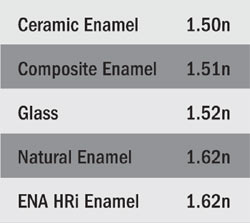 | 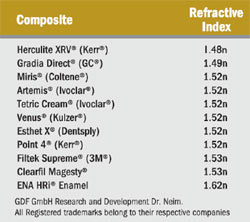 | |
| Figure 1 Comparison of refractive indices. | Figure 2 Comparison of refractive indices for composite materials. | |
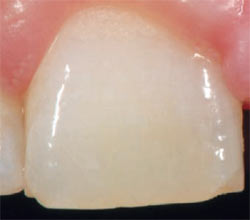 | 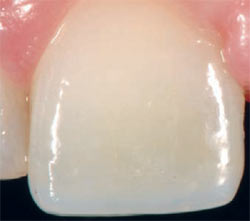 | |
| Figure 3 Frontal view before restoration. | Figure 4 Frontal view after restoration with ENA HRi Universal Enamel. | |
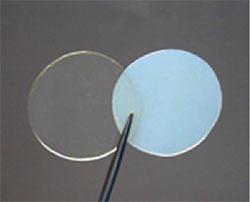 | 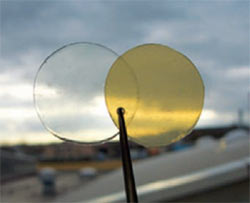 | |
| Figure 5 Example of HRi refraction outside. | Figure 6 Example of HRi refraction in studio. | |
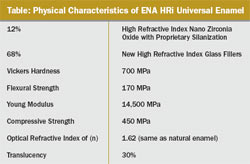 |



